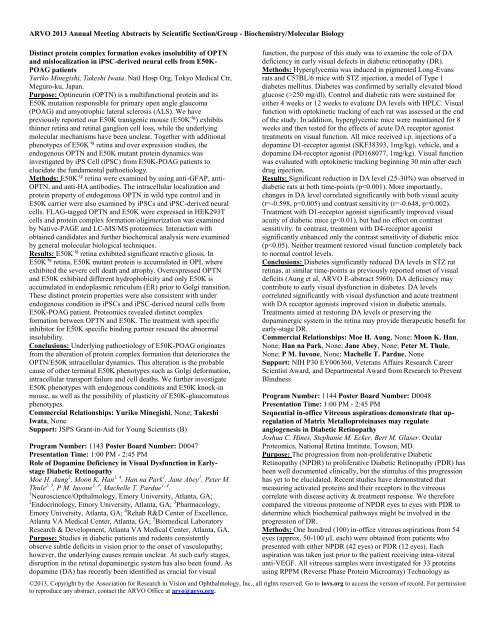Biochemistry/Molecular Biology - ARVO
Biochemistry/Molecular Biology - ARVO
Biochemistry/Molecular Biology - ARVO
You also want an ePaper? Increase the reach of your titles
YUMPU automatically turns print PDFs into web optimized ePapers that Google loves.
<strong>ARVO</strong> 2013 Annual Meeting Abstracts by Scientific Section/Group - <strong>Biochemistry</strong>/<strong>Molecular</strong> <strong>Biology</strong>Distinct protein complex formation evokes insolubility of OPTNand mislocalization in iPSC-derived neural cells from E50K-POAG patientsYuriko Minegishi, Takeshi Iwata. Natl Hosp Org, Tokyo Medical Ctr,Meguro-ku, Japan.Purpose: Optineurin (OPTN) is a multifunctional protein and itsE50K mutation responsible for primary open angle glaucoma(POAG) and amyotrophic lateral sclerosis (ALS). We havepreviously reported our E50K transgenic mouse (E50K -tg ) exhibitsthinner retina and retinal ganglion cell loss, while the underlyingmolecular mechanisms have been unclear. Together with additionalphenotypes of E50K -tg retina and over expression studies, theendogenous OPTN and E50K mutant protein dynamics wasinvestigated by iPS Cell (iPSC) from E50K-POAG patients toelucidate the fundamental pathoetiology.Methods: E50K -tg retina were examined by using anti-GFAP, anti-OPTN, and anti-HA antibodies. The intracellular localization andprotein property of endogenous OPTN in wild type control and inE50K carrier were also examined by iPSCs and iPSC-derived neuralcells. FLAG-tagged OPTN and E50K were expressed in HEK293Tcells and protein complex formation/oligimerization was examinedby Native-PAGE and LC-MS/MS proteomics. Interaction withobtained candidates and further biochemical analysis were examinedby general molecular biological techniques.Results: E50K -tg retina exhibited significant reactive gliosis. InE50K -tg retina, E50K mutant protein is accumulated in OPL whereexhibited the severe cell death and atrophy. Overexpressed OPTNand E50K exhibited different hydrophobicity and only E50K isaccumulated in endoplasmic reticulum (ER) prior to Golgi transition.These distinct protein properties were also consistent with underendogenous condition in iPSCs and iPSC-derived neural cells fromE50K-POAG patient. Proteomics revealed distinct complexformation between OPTN and E50K. The treatment with specificinhibitor for E50K specific binding partner rescued the abnormalinsolubility.Conclusions: Underlying pathoetiology of E50K-POAG originatesfrom the alteration of protein complex formation that deteriorates theOPTN/E50K intracellular dynamics. This alteration is the probablecause of other terminal E50K phenotypes such as Golgi deformation,intracellular transport failure and cell deaths. We further investigateE50K phenotypes with endogenous conditions and E50K knock-inmouse, as well as the possibility of plasticity of E50K-glaucomatousphenotypes.Commercial Relationships: Yuriko Minegishi, None; TakeshiIwata, NoneSupport: JSPS Grant-in-Aid for Young Scientists (B)Program Number: 1143 Poster Board Number: D0047Presentation Time: 1:00 PM - 2:45 PMRole of Dopamine Deficiency in Visual Dysfunction in EarlystageDiabetic RetinopathyMoe H. Aung 1 , Moon K. Han 1, 4 , Han na Park 1 , Jane Abey 1 , Peter M.Thule 2, 5 , P M. Iuvone 1, 3 , Machelle T. Pardue 1, 4 .1 Neuroscience/Opthalmology, Emory University, Atlanta, GA;2 Endocrinology, Emory University, Atlanta, GA; 3 Pharmacology,Emory University, Atlanta, GA; 4 Rehab R&D Center of Excellence,Atlanta VA Medical Center, Atlanta, GA; 5 Biomedical LaboratoryResearch & Development, Atlanta VA Medical Center, Atlanta, GA.Purpose: Studies in diabetic patients and rodents consistentlyobserve subtle deficits in vision prior to the onset of vasculopathy;however, the underlying causes remain unclear. At such early stages,disruption in the retinal dopaminergic system has also been found. Asdopamine (DA) has recently been identified as crucial for visualfunction, the purpose of this study was to examine the role of DAdeficiency in early visual defects in diabetic retinopathy (DR).Methods: Hyperglycemia was induced in pigmented Long-Evansrats and C57BL/6 mice with STZ injection, a model of Type 1diabetes mellitus. Diabetes was confirmed by serially elevated bloodglucose (>250 mg/dl). Control and diabetic rats were sustained foreither 4 weeks or 12 weeks to evaluate DA levels with HPLC. Visualfunction with optokinetic tracking of each rat was assessed at the endof the study. In addition, hyperglycemic mice were maintained for 8weeks and then tested for the effects of acute DA receptor agonisttreatments on visual function. All mice received i.p. injections of adopamine D1-receptor agonist (SKF38393, 1mg/kg), vehicle, and adopamine D4-receptor agonist (PD168077, 1mg/kg). Visual functionwas evaluated with optokinetic tracking beginning 30 min after eachdrug injection.Results: Significant reduction in DA level (25-30%) was observed indiabetic rats at both time-points (p
















